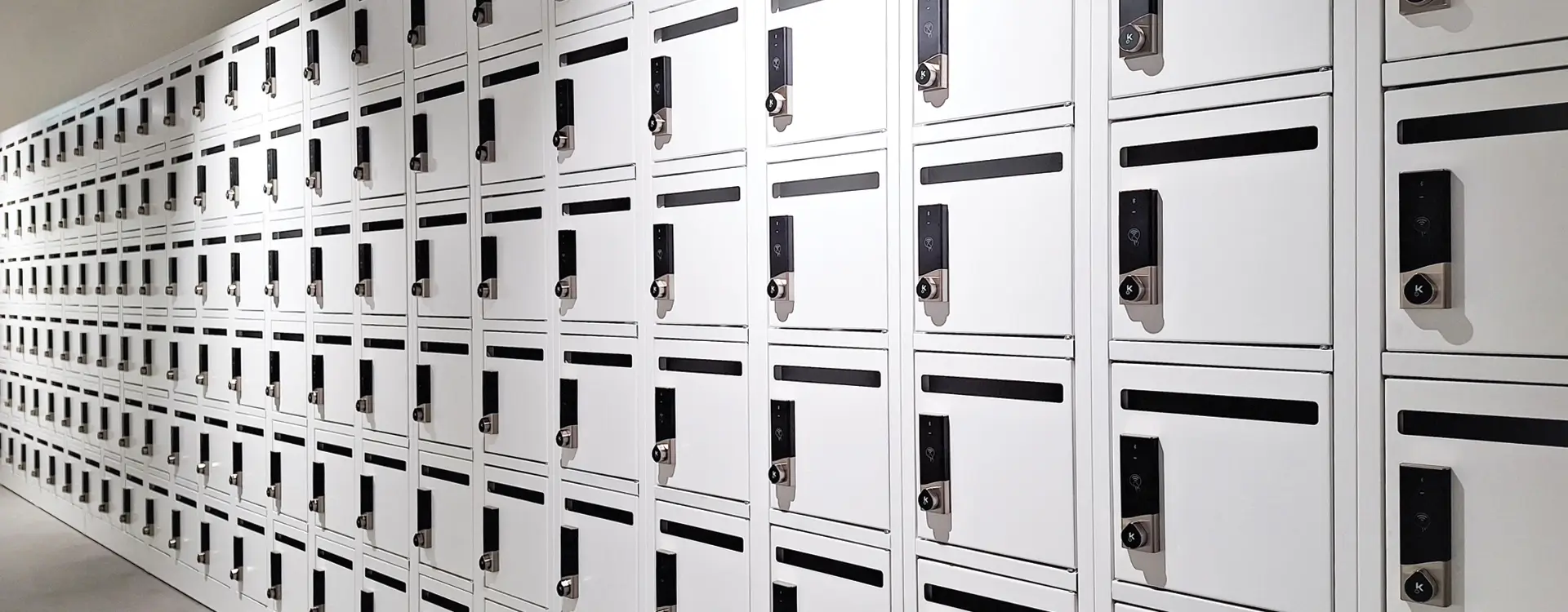- Blog
- Optimizing IT and Asset Management for Maximum Efficiency
Optimizing IT and Asset Management for Maximum Efficiency
Effective: 21/12/2023


Smart Lockers for IT and Asset Management: why are they important? In today’s fast-paced and ever-evolving business landscape, efficient IT and asset management have become critical aspects of organizational success. Organizations across industries are realizing the importance of these functions in staying competitive, minimizing costs, and maximizing productivity. This article delves into the key elements of IT and asset management, explores the steps to optimize these processes, discusses ways to measure their efficiency, and provides insights on overcoming challenges in their optimization.
Effective IT and asset management involve the strategic planning, coordination, and control of an organization’s information technology resources and physical assets. These resources encompass computers, software, networks, data centers, and all other hardware and software components that support the company’s operations.
By effectively managing IT resources and physical assets, businesses can enhance operational efficiency, streamline processes, and ensure the smooth functioning of their operations. Furthermore, it allows organizations to optimize resource allocation, minimize downtime, reduce costs, and enhance security measures.
The importance of IT and asset management cannot be overstated. In today’s highly digitized and interconnected world, organizations heavily rely on technology to carry out their day-to-day activities. Without proper management of IT resources, businesses may face numerous challenges, including system failures, data breaches, and inefficient processes.
One of the key benefits of IT and asset management is the ability to optimize resource allocation. By effectively managing IT resources, organizations can ensure that each component is utilized to its full potential. This means that there is no wastage of resources, and the organization can make the most out of its investments.
Moreover, IT and asset management help minimize downtime. Downtime refers to the period during which a system or asset is not operational. This can be due to various reasons such as hardware failure, software glitches, or network issues. By proactively managing IT resources and physical assets, organizations can identify potential issues before they escalate into major problems, thus reducing the risk of downtime.
IT management encompasses a range of activities that revolve around the planning, deployment, monitoring, and maintenance of an organization’s IT infrastructure. This includes managing the hardware, software, networks, databases, and ensuring the availability and security of information systems.
Asset management, on the other hand, involves tracking, monitoring, and optimizing the lifecycle of an organization’s physical assets. This includes the acquisition, maintenance, and disposal of assets, as well as ensuring their proper utilization and maximizing their value.
IT and asset management are closely intertwined and complement each other. While IT management focuses on the digital aspects of an organization’s operations, asset management deals with the physical resources that support those operations. Together, they form a comprehensive approach to managing an organization’s resources and ensuring their optimal performance.
IT and asset management play a pivotal role in supporting and driving business operations. They ensure the availability and reliability of IT systems, minimize the risk of data breaches, and optimize resource allocation. Additionally, effective management of physical assets enables organizations to make informed decisions regarding their utilization, maintenance, and replacement.
These functions also help businesses stay compliant with industry regulations, meet customer demands, and adapt to technological advancements. Furthermore, they facilitate effective decision-making by providing real-time insights into IT and asset performance, enabling organizations to make data-driven choices that drive growth and innovation.
Another important aspect of IT and asset management is the enhancement of security measures. In today’s digital landscape, organizations face numerous cybersecurity threats. By effectively managing IT resources and physical assets, businesses can implement robust security protocols, such as firewalls, encryption, and access controls, to protect sensitive data and prevent unauthorized access.

Furthermore, IT and asset management enable organizations to adapt to technological advancements. Technology is constantly evolving, and businesses need to stay up to date with the latest trends and innovations to remain competitive. By effectively managing IT resources, organizations can embrace new technologies, such as cloud computing, artificial intelligence, and the Internet of Things (IoT), to drive innovation and gain a competitive edge.
In conclusion, IT and asset management are crucial for the success and sustainability of organizations. They ensure the efficient utilization of resources, minimize risks, enhance security measures, and drive innovation. By investing in effective IT and asset management practices, businesses can position themselves for long-term growth and success in today’s rapidly changing business landscape.
To optimize IT and asset management, organizations must focus on several key elements. Let’s explore two crucial aspects in detail.
A well-defined strategic plan is essential for effective IT and asset management. This involves setting clear objectives, aligning IT and asset strategies with overall business goals, and establishing a framework to guide decision-making and resource allocation.
Strategic planning also involves assessing the current state of IT and asset management, identifying gaps or areas for improvement, and setting measurable targets to track progress. Regularly reviewing and updating the strategic plan ensures that it remains aligned with the organization’s evolving needs and helps optimize IT and asset management practices.
To optimize asset management, organizations must leverage technology solutions that enable efficient tracking, monitoring, and maintenance of physical assets throughout their lifecycle. Asset management software and advanced tracking systems can streamline processes, enhance visibility, and improve decision-making.
Integrating technology also allows for effective asset utilization, preventive maintenance scheduling, and automated inventory management. By leveraging digital tools, organizations can optimize asset lifecycles, reduce costs, and improve operational efficiency.
In order to achieve maximum efficiency in IT and asset management, organizations should follow a systematic approach. Let’s explore two critical steps that can help organizations optimize their processes:
An IT and asset audit involves conducting a comprehensive assessment of existing resources, processes, and workflows. This step helps identify inefficiencies, vulnerabilities, and areas for improvement. The audit should encompass hardware, software, data management practices, security protocols, compliance requirements, and asset utilization.
By conducting an audit, organizations gain valuable insights into their IT and asset management practices and can make informed decisions regarding resource allocation, process optimization, and technology integration.
Implementing robust IT and asset management tools is crucial for optimizing processes. These tools facilitate efficient monitoring, maintenance, and control of IT systems and physical assets.
Organizations should carefully select and implement software solutions that align with their specific needs and goals. These tools can automate tasks, improve visibility, provide real-time data and analytics, and enable proactive decision-making. Seamless integration with existing IT infrastructure is key to achieving maximum efficiency.
To ensure continuous improvement and gauge the effectiveness of IT and asset management, organizations must establish metrics and key performance indicators (KPIs) to measure performance. Two key areas to focus on are:
Aligning KPIs with organizational goals and objectives is essential to measure the effectiveness of IT and asset management practices. KPIs can include metrics such as system uptime, response time, asset utilization rates, mean time between failures, and overall cost of ownership.
Regularly monitoring these indicators helps organizations identify bottlenecks, areas requiring improvement, and opportunities for optimization. By establishing benchmarks and tracking progress, organizations can continuously improve their IT and asset management practices, ensuring maximum efficiency and effectiveness.
Efficiency in IT and asset management is not a static goal. It requires regular reviews, assessments, and improvements. Organizations should establish a culture of continuous improvement, provide regular training and development opportunities for IT and asset management teams, and encourage collaboration and knowledge sharing.
By actively seeking and implementing feedback and learning from industry best practices, organizations can stay ahead of the curve and optimize their IT and asset management processes to achieve maximum efficiency and drive business success.
While optimizing IT and asset management can bring significant benefits, it is not without its challenges. Two common obstacles that organizations may face are:
Implementing changes in IT and asset management practices may face resistance or even encounter technological and cultural barriers. It is crucial for organizations to address these challenges by fostering a culture of change, providing adequate training and support, and clearly communicating the benefits of optimization.
Aligning IT and asset management initiatives with overall business goals and securing leadership support can also help overcome resistance and ensure successful optimization.
In addition to addressing challenges, organizations can learn from industry best practices to achieve optimal results. Implementing ITIL (Information Technology Infrastructure Library) frameworks for IT management and ISO 55000 standards for asset management can provide guidance and help establish efficient processes and workflows.
Moreover, leveraging cloud computing, AI-powered analytics, and IoT (Internet of Things) can enhance IT and asset management capabilities and pave the way for future innovation and automation.
In conclusion, optimizing IT and asset management is essential for maximizing efficiency and driving business success. By understanding the importance of these functions, focusing on key elements, following a systematic approach, measuring performance, and overcoming challenges, organizations can achieve optimal results. Embracing innovation, fostering collaboration, and continuously improving processes will pave the way for a more efficient and effective IT and asset management landscape.
At Keynius, we understand the critical importance of security in various industries. Our locking solutions are designed to provide the highest level of security and control over access to your valuable assets. Whether you need to secure storage spaces, manage IT and assets, streamline parcel management, provide efficient dispensing services, offer vending and rental solutions, or ensure event locker security, Keynius has you covered.
Our cutting-edge technology and innovative approach to security empower businesses to optimize their operations while maintaining the utmost protection. Explore our locking solutions to see how Keynius can help you secure your assets and enhance your organization’s efficiency.
At Keynius, we believe that one size does not fit all when it comes to security and access control. That’s why we offer customizable locking solutions that can be tailored to meet the specific needs of your industry. Our expertise extends across various sectors, including office environments, sports and leisure facilities, educational institutions, emergency services, retail establishments, healthcare facilities, pharmacies, public spaces, industrial sites, and more.
With Keynius, you can expect a personalized approach to security that aligns with your industry’s requirements. We work closely with our clients to understand their unique challenges and provide solutions that enhance security, efficiency, and peace of mind.
If you’re ready to take your security and access control to the next level, contact Keynius today. Our team of experts is here to assist you in finding the perfect locking solutions for your needs. With our wide range of products, including locker software, wired locking systems, battery-powered locking solutions, and secure payment options, we have the tools to transform the way you manage access and security.
Let Keynius be your trusted partner in securing your assets and improving your operations. Contact us today to schedule a consultation and discover how we can tailor our solutions to fit your requirements.
Keynius offers secure access control systems that can be customized to suit the specific security needs of office spaces. Our solutions provide efficient management of storage areas, enhancing overall office security.
In the sports and leisure sector, Keynius offers locker systems that ensure the safe storage of personal belongings, providing convenience and security for patrons.
Keynius offers access control solutions designed for educational environments, helping schools and universities secure assets while streamlining operations.
Our locking solutions for emergency services ensure quick and secure access to critical equipment, improving response times and overall safety.
Keynius provides retail businesses with advanced security solutions, including theft prevention and efficient storage management.
Keynius offers locking solutions that safeguard sensitive medical equipment and supplies, helping healthcare facilities maintain a high standard of security and efficiency.
Are you interested in one of the locking solutions or would you like more information about the possibilities for your company? We’d be happy to welcome you to our showroom for a pleasant initial meeting, free of obligation.
Contact us